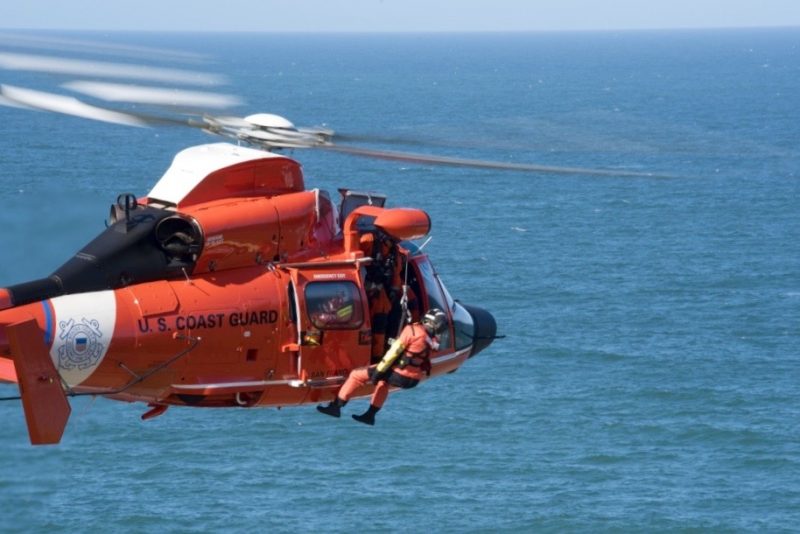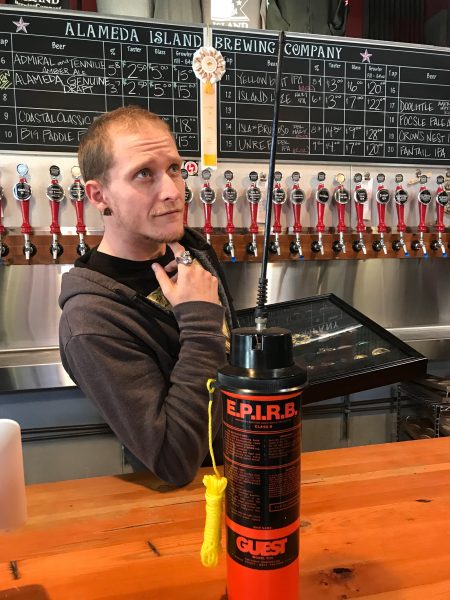
Why You Should Have an EPIRB
Hello readers! My name is Layne Carter and I am your friendly Coast Guard Search and Rescue (SAR) Specialist at the Coast Guard’s Joint Rescue Coordination Center (JRCC) Alameda. Every Coast Guard District has a SAR Specialist like me who is charged with being the regional SAR subject-matter expert. My counterparts from the other nine Coast Guard Districts and two Rescue Sub-Centers (Guam and San Juan) and I provide policy guidance, observe trends, monitor emerging technology, and generally advise our military counterparts on all things SAR.
At JRCC Alameda, we coordinate quite a few rescues involving EPIRBs (Emergency Position Indicating Radio Beacons) in the sailing community. So what better topic to start with than a little overview of SARSAT and how the Coast Guard utilizes this system to help save lives every day? What is SARSAT? SARSAT (Search and Rescue Satellite Aided Tracking) uses a network of satellites, ground stations, mission control centers, and RCCs (like JRCC Alameda) to detect beacons (EPIRBs, PLBs, and ELTs), so we can send rescuers to your aid. It is a free, humanitarian service that only requires you to own and properly register a beacon. There are no registration fees, no fees for a rescue, and the system is monitored 24/7 at no cost to you. It is a global effort to ensure that if you are in peril and activate this device, someone will be looking for you.
So far this year, 38 people have been rescued at sea thanks to SARSAT. Globally, more than 43,000 people have been rescued since 1982. What does that mean to you? It means this system has been around a long time, and with time comes experience. (All statistics I post in this article refer to the NOAA SARSAT web page at www.sarsat.noaa.gov.) Between NOAA, the US Air Force, the US Coast Guard, and our global SAR partners, we have learned a lot about SARSAT and have been applying that experience and lessons learned to every part of the process from technology to search methods. Today’s SARSAT program is light-years ahead of where it was even 10 years ago and is only getting more accurate and efficient every day.

Let’s talk about the technology. It is important to know what your beacon is capable of doing and what it cannot do. Will it activate when immersed in water? Will it automatically include a GPS-encoded position in the first signal sent to the satellites? These are important factors to consider as they greatly aid in our ability to get help to you when you need it most. Personally, I use a beacon that activates when it hits the water without any human intervention. If an unexpected tragedy strikes and my boat goes down before I can reach that EPIRB or PLB, I have a sense of comfort knowing my self-activating EPIRB will get the word out, even if I am not able to do so myself. In addition, it sends an encoded GPS position, which reduces the time it takes for rescuers to find me.
New beacon technology is on its way! Second-generation beacons are being developed as we speak and should reduce cost, increase accuracy, and potentially provide additional capabilities such as AIS plotting and return link service (RLS). RLS will allow the individual activating the beacon to receive a notification when their alert has been received, among other potential benefits. So keep your eyes out for these second-generation beacons. (I do not have a solid timeline, but I anticipate we should be seeing them hit the market sometime within the next couple of years.)
So what happens when you activate your beacon? The device sends a very powerful signal up to our anxiously-awaiting satellites, where it is then routed straight to the RCCs without any human intervention. There are currently three constellations up there, LEO (Low Earth), MEO (Mid Earth) and GEO (Poles). Each satellite constellation serves a specific purpose and processes the information it receives differently. LEOs use the Doppler effect to determine a position. GEOs just relay the fact that a beacon has activated and if it is registered it will include contact information, while MEO uses trilateration, which is super-fast (under a minute) and very accurate. More details on the satellites and their capabilities can be found NOAA’s page, mentioned above.
Once an RCC — like JRCC Alameda — receives the alert, the SAR mission planner evaluates the information to determine the level of response. Depending on the satellite that receives the alert and the quality of the signal received by the satellites, the initial position may not be received or may be unreliable. For this reason, we rely heavily on the details provided in the registration information that we receive with the alert. We will attempt to call you or your emergency points of contact to determine if you are underway or if your boat is sitting at the pier. If we have a position in a maritime environment, we are making one or two calls to your primary contact numbers and launching an asset immediately (usually simultaneously). It is important to remember that launching an aircraft or a boat in response to a perceived emergency is inherently dangerous. Our coxswains and pilots assume a certain amount of risk every time they launch, so if you accidentally activate your beacon, it is crucial you let the Coast Guard know as soon as possible.
More often than not, if we receive a bad position (unreasonable for the type of vessel or terrain, e.g. a small helicopter 1000 nautical miles west of California) or no position at all in the initial alert, it is likely because the beacon is being shielded by a structure of some sort or in a garbage dump. In one case, an EPIRB was donated to a local watering hole and was hanging next to the bar where patrons could turn it on and off to see pretty lights flashing. We will spend a significant amount of time trying to track down the owner using the information provided on the beacon’s registration, coupled with publicly available information to generate leads.

So keeping that registration information current is very important. It is worth mentioning that only the US Coast Guard and NOAA can access the emergency contact information. We take your privacy very seriously, and restrict access to the database to SAR mission planners in the US Coast Guard.
I will finish with one final point. We treat each alert as if it were a member of our own family letting us know they need our help. So when you are out enjoying the tranquility, beauty, and freedom boating has to offer, know that no matter where you are — if your EPIRB, PLB, or ELT is activated in the maritime environment — the people in the world’s finest Coast Guard will be doing everything in our power to get help to your location. Help us help you! Keep your registration current, notify us if you accidentally activate your beacon, and give us a call if you have any questions. We are passionate about saving lives and welcome your questions 24/7.
If you have any questions, you can email Layne Carter here.
